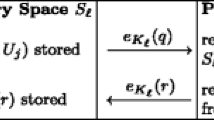Abstract
Anonymous database search protocols allow users to query a database anonymously. This can be achieved by letting the users form a peer-to-peer community and post queries on behalf of each other. In this article we discuss an application of combinatorial configurations (also known as regular and uniform partial linear spaces) to a protocol for anonymous database search, as defining the key-distribution within the user community that implements the protocol. The degree of anonymity that can be provided by the protocol is determined by properties of the neighborhoods and the closed neighborhoods of the points in the combinatorial configuration that is used. Combinatorial configurations with unique neighborhoods or unique closed neighborhoods are described and we show how to attack the protocol if such configurations are used. We apply k-anonymity arguments and present the combinatorial configurations with k-anonymous neighborhoods and with k-anonymous closed neighborhoods. The transversal designs and the linear spaces are presented as optimal configurations among the configurations with k-anonymous neighborhoods and k-anonymous closed neighborhoods, respectively.
Similar content being viewed by others
References
Abel R.J.R., Colbourn C.J., Dinitz J.H.: Mutually orthogonal Latin squares (MOLS). In: Colbourn C.J., Dinitz J.H. (eds.) The CRC Handbook Of Combinatorial Designs, 2nd edn. pp. 160–193. CRC Press, Boca Raton (2007).
Ball S., Bamberg J., Devillers A., Stokes K.: An alternative way to generalise the pentagon. J. Comb. Des. (2012). doi:10.1002/jcd.21325.
Bose R.C., Shrikhande S.S., Parker E.T.: Further results on the construction of mutually orthogonal Latin squares and the falsity of Euler’s conjecture. Can. J. Math. 12, 189–203 (1960)
Dalenius T.: Finding a needle in a haystack or identifying anonymous census record. J. Off. Stat. 2(3), 329–336 (1986)
Dalenius T., Reiss S.P.: Data-swapping: a technique for disclosure control. J. Stat. Plan. Inference. 6(1), 73–85 (1982)
Domingo-Ferrer J.: A Three-Dimensional Conceptual Framework for Database Privacy. Secure Data Management, LNCS 4721/2007, pp. 193–202 (2007).
Domingo-Ferrer J., Bras-Amorós, M.: Peer-to-peer private information retrieval. Privacy in Statistical Databases, Lecture Notes in Computer Science. pp. 315–323 (2008).
Domingo-Ferrer J., Bras-Amorós M., Wu Q., Manjón J.: User-private information retrieval based on a peer-to-peer community. Data Knowl. Eng. 68(11), 1237–1252 (2009)
Gropp H.: Configurations. In: Colbourn C.J., Dinitz J.H. (eds.) The CRC Handbook Of Combinatorial Designs, pp. 352–355. CRC Press, Boca Raton (2007).
Grünbaum B.: Configurations of Points and Lines. American Mathematical Society, Providence (2009)
Hundepool A., Domingo-Ferrer J., Franconi L., Giessing S., Schulte Nordholt E., Spicer K., de Wolf P.-P.: Statistical Disclosure Control. Wiley, West Sussex (2012)
Reiter M.K., Rubin A.D.: Crowds: anonymity for web transactions. ACM Trans. Inf. Syst. Secur. 1(1), 66–92 (1998)
Samarati P., Sweeney L.: Protecting privacy when disclosing information: k-anonymity and its enforcement through generalization and suppression. SRI International Technical Report (1998).
Lee J., Stinson D.R.: A combinatorial approach to key predistribution for distributed sensor networks. IEEE Wireless Communications and Networking Conference, CD-ROM, paper PHY53-06, pp. 6 (2005).
Pfitzmann A., Khntopp M., Federrath H.: Anonymity, unobservability, and pseudonymity a proposal for terminology. In Designing Privacy Enhancing Technologies, Lecture Notes in Computer Science, Springer Berlin, pp. 1–9. (2009). An updated version of this document can be found at the following URL: “http://dud.inf.tu-dresden.de/literatur/Anon_Terminology_v0.34.pdf” (2001). Accessed Feb 2012.
Spink A., Wolfram D., Jansen M.B.J., Saracevic T.: Searching the web: the public and their queries. J. Am. Soc. Inf. Sci. Technol. 52(3), 226–234 (2001)
Stokes K., Bras-Amorós M.: On query self-submission in peer-to-peer user-private information retrieval. Proceedings of the 4th International Workshop on Privacy and Anonymity in the Information Society (PAIS’11), ACM, New York, NY, USA. 978-1-4503-0611-9 (2011).
Stokes K., Bras-Amorós M.: Optimal configurations for peer-to-peer user-private information retrieval. Comput. Math. Appl. 59(4), 1568–1577 (2010)
Stokes K., Bras-Amorós M.: Combinatorial structures for an anonymous data search protocol. Proceedings of Workshop on Computational Security, CRM (UAB), Barcelona, November 28–December 2, (2011).
Swanson C.M., Stinson D.R.: Extended combinatorial constructions for peer-to-peer user-private information retrieval. CoRR abs/1112.2762 (2012).
Sweeney L.: k-anonymity: a model for protecting privacy. Int. J. Uncertain. Fuzziness Knowl. Syst. 10(5), 557–570 (2002)
Teevan J., Adar E., Jones R., Potts M.: History repeats itself: repeat queries in Yahoos query logs. In Proceedings of the 29th Annual ACM Conference on Research and Development in Information Retrieval, SIGIR 06. pp. 703–704 (2005).
Westin A.F.: Privacy and Freedom. Atheneum, New York (1967)
Willenborg L., DeWaal T.: Elements of Statistical Disclosure Control. Springer, New York (2001)
Author information
Authors and Affiliations
Corresponding author
Additional information
Communicated by W. H. Haemers.
Rights and permissions
About this article
Cite this article
Stokes, K., Farràs, O. Linear spaces and transversal designs: k-anonymous combinatorial configurations for anonymous database search notes. Des. Codes Cryptogr. 71, 503–524 (2014). https://doi.org/10.1007/s10623-012-9745-8
Received:
Revised:
Accepted:
Published:
Issue Date:
DOI: https://doi.org/10.1007/s10623-012-9745-8
Keywords
- Anonymous database search
- Combinatorial configuration
- Partial linear space
- Neighborhood
- Linear space
- Transversal design
- k-Anonymity




